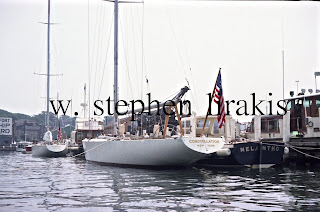Looking back from today’s perspective makes the gear and sails in particular look primitive. I is hard to imagine that the 12 meters of the era were the cutting edge of sailing. Look at the boom vang in the earlier post. The mainsheet winch, practically the smallest winch on the boat for the largest sail; and four parts. Just think what that must have been like at the leeward mark.
Hanks were still used on headsails. I believe an argument could be mounted defending hanks, tactically, look at the photo of the bow of “Constellation”, Buddy Bombard is standing in the forward hatch, a jib would be stopped and hoisted through this hatch; sheets attached, at a leeward mark, a boat could carry the spinnaker right to the mark, breaking out the genoa at the last possible moment.
Wooden boats built to lloyd’s scantlings. Designers and builders did what they could to save weight. I would not be until 1974 when aluminum would be allowed and 1986 when the first fiberglass 12 meters came into being.
Weather, was not much beyond the farmer’s almanac. Statics accumulated over time were the only analysis available.
Ash blocks with bronze bearings were still common. Lines were still large and heavy. Change came slowly


Love the in depth coverage. Keep it coming.
In his YACHTING series on the 1958 America's Cup from a deck hand's perspective — articles that strirred at least one 14 year old's imagination and ambitions — Toby Tobin described Rod Stephens as so knowledgable and focused that he knew the weight of every fastening in the boat. That's how fine calculations got. In fact, this klnowledge was important that year because when the glue didn't set on Columbia's laminated frames, they had to be held together with screws. There went several pounds of ballast.